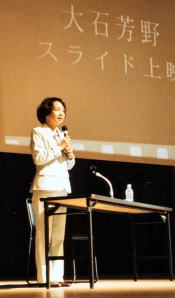
No.211[Q

Photo: (Center) Mrs. Kato,
president of Meguro UNESCO Association, made the opening speech.
The flags on the stage
described 63 countries of the participants of the UNESCO International Youth
Retreat for the past 15 years.
Sponsored
by Meguro UNESCO Association / Co-sponsored by Board of Education of Meguro
City
Supported
by Meguro City, Meguro International Friendship Association and National
Federation of UNESCO Associations in Japan
gUNESCO Gatheringh which celebrated the 50th anniversary of Meguro UNESCO Association was held at 2 ofclock in the afternoon of October 2 (Sat.) at the main hall of the Meguro Persimmon Hall. Decorated with national flags of various countries, it started with a strong sound of Korean traditional drums gJangguh which were played by some friendship members and their friends.
The ceremony started with a greeting speech by Mrs. Kato, the president, then congratulatory addresses were given by the guests from Japanese National Commission for UNESCO, National Federation of UNESCO Associations in Japan, Meguro City, etc. They all expressed their heartfelt expectations for activities of Meguro UNESCO Association.
In part II, a memorial speech gLive for Tomorrowfs Worldh was given by Ms. Yoshino Oishi, a photojournalist.
For part III, recitation of selected poems from gRoad to the Futureh, a collection of childrenfs poems, was held by Ms. Yuki Tachibana. The recitation was very impressive with piano accompaniment and also a percussion performance by children of Higashine Elementary School. The poems were collected from all over the world under the themes gWishing for peaceh, gDreamh, gHopeh or gLoveh, and we received about 1,000 poems from children of 6 to 15 years old from Japan and other countries overseas. The poems presented on the stage were very creative and rich of sensibility, describing their feelings through simple words. Also, the audience was enchanted with the regional and cultural characteristics possessed by each poem.
MY FAVORITE HIMALAYAS: The white,
great Himalayas / Are you covered with sugar powder? c
@@THE @SYMPHONY OF COLOURS: Purple is the turbulent character of a Georgian
man
@@@/ The whiteness of the light pierces the
darkness of black c
@@ DELIVER THE PEACE!: Do not give
up your dream / Do not abandon your hope
c
The gathering was followed by a tea party in the foyer with a warm atmosphere. The day was a memorable one to look back on the 50 years of our history, and make a fresh resolution for the future starting from tomorrow.
- Moriaki Saito, public relationship committee
 Part 2: Memorial Speech gLive for
Tomorrowfs Worldh
Part 2: Memorial Speech gLive for
Tomorrowfs Worldh
Talk and Photos by Ms Yoshino Oishi, a photojournalist 49 slides projected on a screen
I hear that Meguro UNESCO Association was established in Meguro ward assembly hall 50 years ago in 1954, when the Dien Bien Phu Basin fell to the control of the Democratic Republic of Vietnam in northern Vietnam bordering with Laos in Indochina. The subsequent conclusion of Geneva Agreements put an end to the French rule of the country. Ms Oishi visited Vietnam to see with her own eyes the ceremony of the fiftieth anniversary of the fall of Dien Bien Phu and of the conclusion of the Geneva Agreements just before attending the fiftieth anniversary event of Meguro UNESCO Association.
Ms Oishi illustrated peoplefs unpretentious look with pictures she had
taken in the streets of Vietnam, Cambodia, Indonesia, Afghanistan, Bangladesh,
and other Asian countries. In the pictures you find a rich man laughing,
poor child smiling pleasantly, inner-city children washed with soap in
the chilly weather, a Philippine child scavenging through rubbish dumps
for anything that could be of any use to him, a boy with a leg blown off
by a landmine selling newspapers, contrasting a man on his stomach removing
landmines. He could get rid of one mine a day at most when numerous land
mines are being laid anew somewhere on the earth every day.
One of the pictures shows a man driving a herd of cattle. Every cow is
thin. The cattle drover is also thin. Ms Oishi said that many such people
have a perforated stomach due to lack of food and long working hours. The
amount of the food all the Bangladesh people eat is equal to that of the
food the Japanese people discards as leftovers. This fact made me downright
baffled. She said the scenes were reminiscent of the post-war Japan, from
which Japan had dramatically changed. Has Japan changed in a favorable
way? I said to myself.
That said, I believe not just me but many other people would find a ray
of hope in those poor, lively children who will build a future on the earth.
- Youich Shimosato, Public Relations Committee